I’ve self-published three books for my fantasy book series Ringlander. Here in this article I will explore some of challenges I have met along the way, including Editing, Cover Design, Formats and Platforms and Marketing.

Quick links
- Before you publish
- Step 1 – Editing
- Step 2 – The Cover
- Step 3 – Formats and Platforms
- Bonus Step – Marketing
Starting at the end
Writing a book is the hardest creative endeavour I’ve ever undertaken. Just getting to the end is a massive acheivement. So grab that whisky, wine, coffee, tea, the blood of your enemies and soak your liver in it, because you just did something that few people can manage.
Finished? Great. Because now we begin.
Before you publish
We’re going to assume a couple of things going in:
- You finished the book
- You’re ready to show it to people
Essentially you are no longer a writer but a designer, marketeer and reader. You will wear many hats throughout this process, and while that is the strength of self-publishing it is also the biggest obstacle to traverse. You will find yourself in new waters trying to grasp new concepts, and it will feel like a lot to do, but once you’re seasoned, you will have complete power over your own literary destiny.
Consider your Goals
Why do you want to self publish? For me, I wanted to own the process, but I have a skillset in design and knew it wouldn’t be a huge leap for me to understand. (I was proved wrong many, many times)
I had started my writing career by querying agents, as is the way, and while I got some nibbles and even some manuscript requests, ultimately I decided I wanted to get the book out there as soon as possible. I was excited by what I had written (even after having spent a year loitering in slush piles and 7 years writing) and wanted people to read it.
Step 1 – Editing
My book Ringlander: The Path and the Way was “finished” multiple times, to the point where I was still making edits after it was live. The beauty of self publishing though is that you can make those changes without having to consult editors or order new books as you would in the traditional publishing world.
A big advantage that traditional publishing has over self publishing though is that career editors will be paid to look at your manuscript, that is, people who have spent time in university to become editors and writers themselves, and they know good prose when they see it. They will often proof read it a number of times too on top of that copy and developmental editing, so by the time your traditional published manuscript hits print, it’s 99.9% error-free. Disclaimer: it will never, ever be 100% error-free.
As an author embarking on self publishing, if you want that level of quality you will have to pay for it. Readers will notice and judge if you leave errors in there. Trust me.
Beta readers
You wrote this story, so unfortunately you will never be able to see it how the reader will. You are therefore obliged to get some eyes on the manuscript, and that’s where beta readers come in. The term “Beta” is coined from software development and is very fitting because you’re in a beta stage of development now, meaning it’s past the gate (Alpha stage) but still needs work and polish before release into the wild.
Where to get beta readers
For book 2 Ringlander: Fallen Shards I put out a general call to my mailing list and about 15 people responded. 6 of those became beta readers and were acknowledged in the final book for doing so. Maybe you have some family or close friends who might like to read your genre? Get in touch with them and drag them in. Finding Beta readers is very tough. You’re asking people to read your book while it is an unfinished state and that requires understanding, will and patience. You owe these people a fizzy beverage or two after wading through your world.
What beta readers did for Ringlander
Abika, the main character in Fallen Shards, was too hard and cold-hearted in the beta drafts, and all of the beta readers (and the editor) picked up on it. It was very a clear sign for me to:
- Make her character more believable
- Make the reasons for why she was cold-hearted very clear
My beta readers helped me understand that Abika’s character arc, as the main character in book 2 Ringlander: Fallen Shards, was absolutely pivotal to the reader’s understanding and enjoyment of the story. It also helped me draw in and shine a light on the emotional elements, because people don’t remember what happens in the thing, just how the thing made them feel.
The beta readers for Ringlander: Fallen Shards helped shape and polish my characters and the plot, and without them the story would have suffered as a result.
Hire an editor
After the Beta readers are done, it’s time to edit, however, it is not your job to edit the book, it is your job to write it. The story, the characters, the setting, this is your playground. When you’re done, hand it over to someone else and pay them to find errors. Ask the editor how deep they will go. Do you want them to suggest story or character changes? (developmental editing) or just stick to structure of the prose (copyediting). Have this conversation with them and put yourself out there. You don’t have to accept every change, but you should be open to the idea that what you have created is not perfect. Yet.
Incidentally, if you’re looking for an editor in the fantasy genre give Dom McDermott a shout. He was fantastic for me and gave some honest and professional feedback that elevated my work.
Step 2 – The Cover
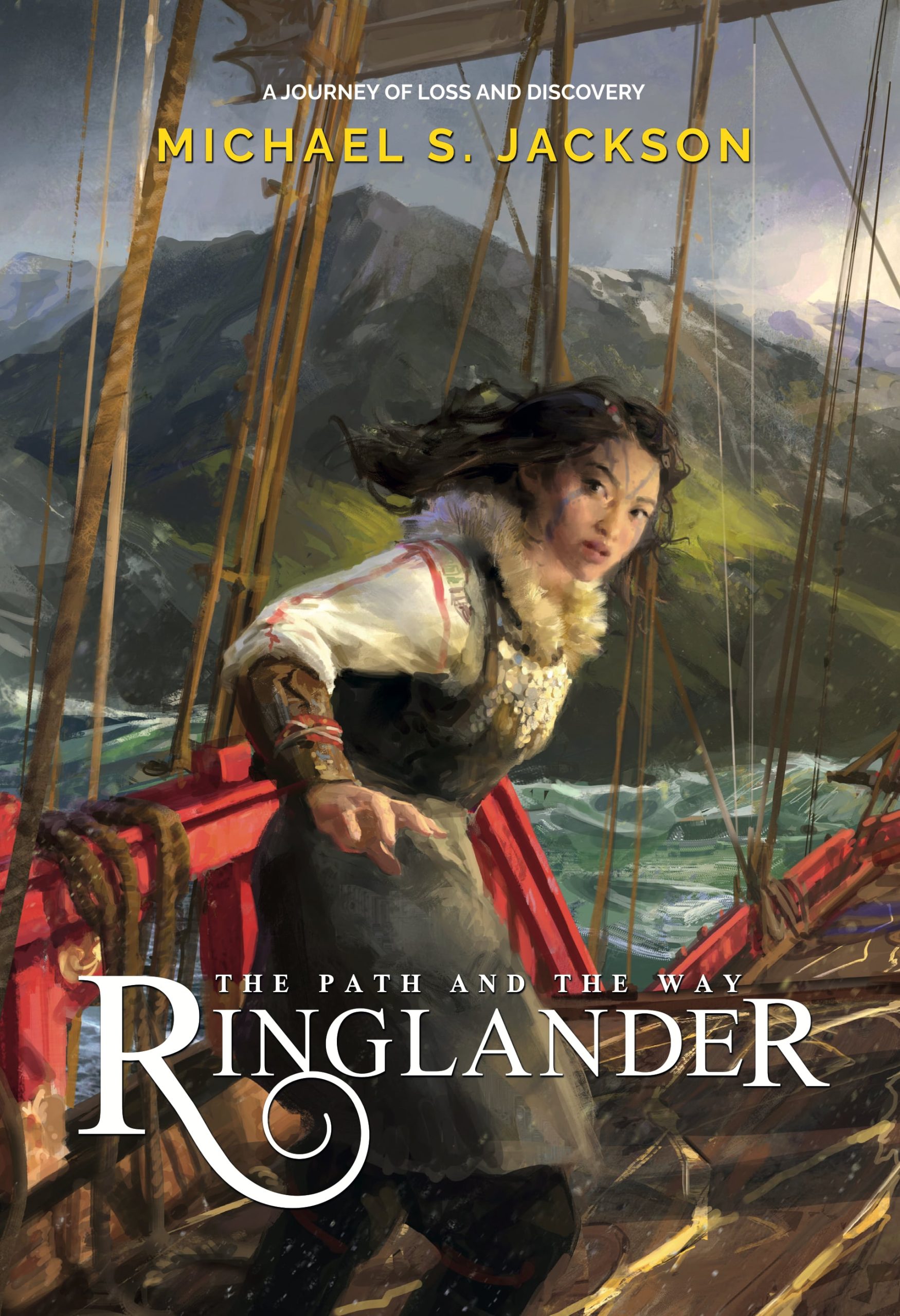
For Ringlander: The Path and the Way was my first book, and as a designer I was super excited to talk to artists about collaborating on the cover. I work in marketing, so I know the difference a good cover makes to the product, and I cannot understate how important it is. We do all literally judge books by their covers.
I’m going to include price ranges too to show you just how important, overwhelming and rewarding art spend can be.
Finding an artist or cover designer
I relished the journey for a great artist. I spoke to maybe 4 or 5, but chose John Anthony Di Giovanni as my favourite. This started as a simple enquiry on their websites after discovering their work through the fantasy community on Twitter (forever it shall be known) and on Artstation. I sent them all some of my work in the initial query too, so not to waste their time, because great artists are usually very busy. I chose 3 very descriptive and evocative scenes to send, because I had to show off that the visual element of the story and show them I meant business.
In the fantasy genre, art is a very important part of the story, so separating the art from the typography was an obvious thing to do. You might instead choose the cover designer route, where a designer will create the entire cover for you. For literary or speculative fiction which are all about bold covers that strike at the heart of the reader and the story, you could potentially have the cover designer do both. So keep your genre in mind, and observe that market. Go to a book store and stand in front of the bestsellers, and take note of which ones jump out at you.
Almost winning an award
Ringlander: The Path and the Way has been nominated for a bunch of awards, but there was one I wanted desperately. The r/fantasy Stabby awards (The subreddit for fantasy on Reddit) John’s artwork got down to the last two and was pipped at the last this incredible piece by Harkalé Linaï
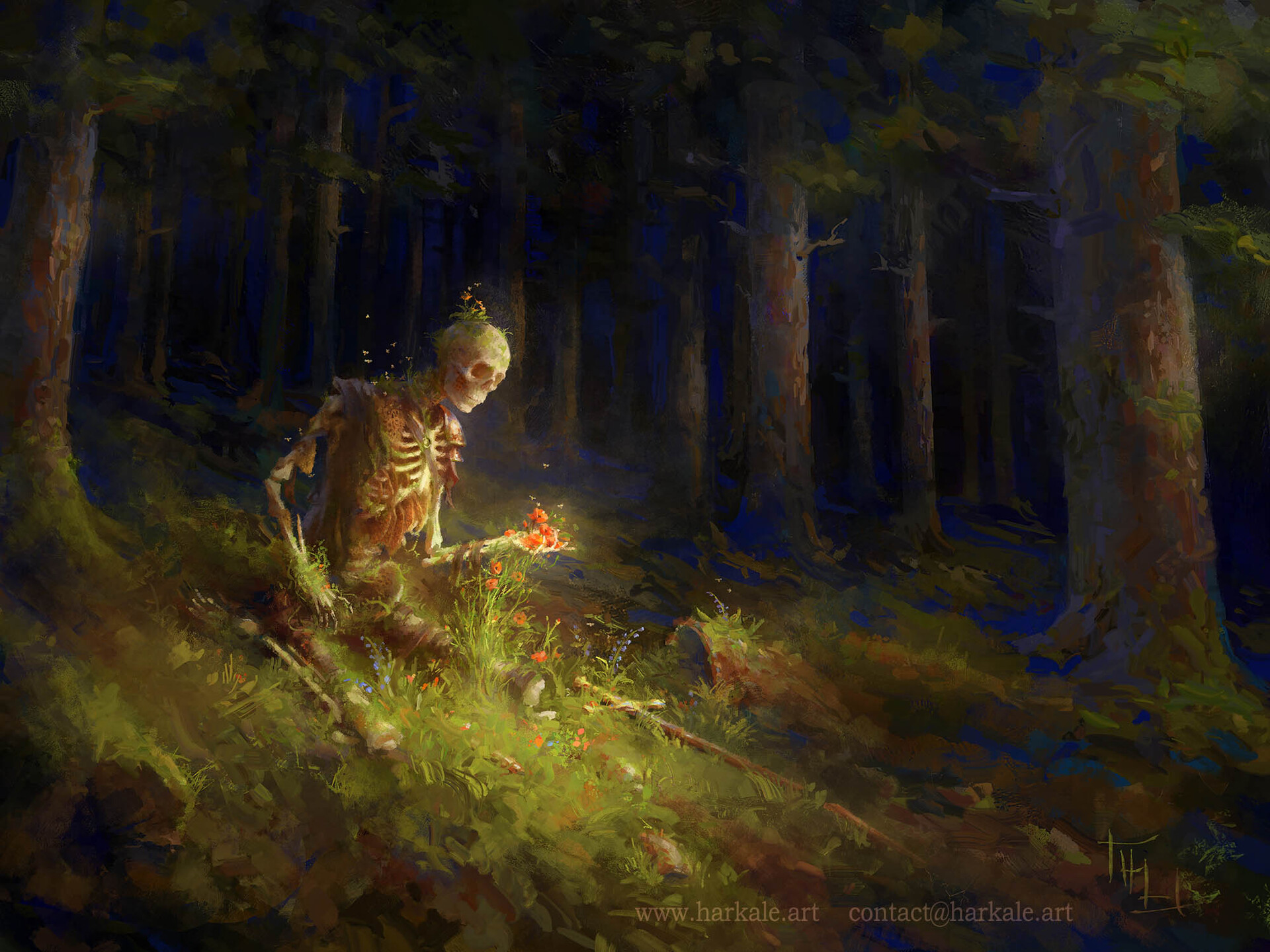
The full finalist list r/fantasy Stabbys 2021
Best artwork of 2021
- Spirits of Vengeance by Felix Ortiz – https://felixortiz.artstation.com/projects/PoQOb8
- Baru Cormorant Fan Art by Marceline2174 – https://mobile.twitter.com/Marceline2174/status/1481357118699892736/photo/3
- Grave to Cradle by Harkalé Linaï – https://www.artstation.com/artwork/X1evD0
- Ocean of Dune Jian Guo – https://www.deviantart.com/breath-art/art/ocean-of-dune-896232861
- Ringlander:The Path and the Way by John Anthony Di Giovanni – https://jad.artstation.com/projects/AqbEKX
Freedom and keeping it professional
When collaborating with an artist, you are working with someone like you in the creative community, and like you they are trying to forge a living in the creative world. Pick someone whose artwork resonates with you and give them freedom to bring your story to life.
Choosing a scene
I had such a profound vision of what I wanted for the cover that I ignored the 3 scenes from my book Ringlander: The Path and the Way and asked John to create comps on that idea instead. Here were those comps.
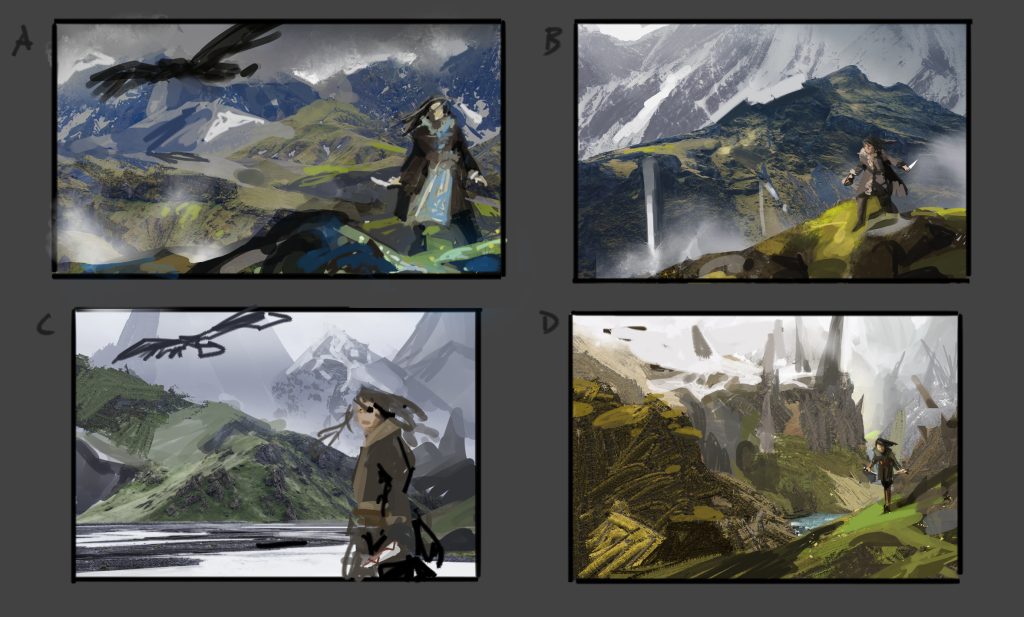
I absolutely loved these, and knew from the second I saw them that I had chosen my artist well. John had understood what I wanted. However, the actual cover I went with is not in here and for a very good reason—that vision I’d had was quite unoriginal.
Placement in the market
Euch. Why should I consider my place in the market? I’m not beholden to them!
Oh, Mike, my sweet autumn child.
Whether you like or not, you are in a market by the fact you are writing a book where other books exist, and you do have to think about how you stand out on a shelf amongst them. So when I looked at John’s comps of a lone main character in a natural setting anew, I realised that I was just doing the same as everyone else, and as much as I loved those ideas, I eventually convinced myself to try a new approach.
First of all, it needed to be exciting and intense and show that the main character was going to be pushed out of her home setting (Kyira, the MC from The Path and the Way HATES boats.) So, I put her on a boat, which as a disclaimer, was actually in the story and not just a random choice!
These comps included 4 more fleshed out angles on the rural “home” side, but ultimately I decided to go with this one, which then became this cover.
Layout and Typography
So I now have a wonderful piece of art for my cover. It’s striking, has a beautiful palette of colours and shows the main character in peril! Now, however it needs a title.
I won’t spend a lot of time discussing choosing a title because your work is your own and will have its own reasons for the title and series title (if you have one). I chose “Ringlander: The Path and the Way” for a few reasons:
- It was completely unique (There were no books or movies that used it) meaning when you search for it on Google, I would hopefully be ranked first.
- It was an important part of the story
- Ringlander highlighted the series as well as the first book name
Choosing the right font (and designer)
Call it want you want, font, typesetting, glyph…You need to arrange the title on your book cover in a striking and bold way so the reader can, at a glance, see what they’re getting. We’ve got the artwork, so now we need to describe the title. Again, this is where designer skills come in handy. If you’re working with a cover designer already, great! They can handle it all. If you’re splitting the art from the layout like it I did, then you might need someone to bring it all together. Digital matte painters won’t usually do this for you.
Being a designer as my day job made this very easy and this is what I did for the Ringlander logo. I chose a font from Google Fonts because I knew it would be easy to use it on a website too meaning I could use the same font across all of my books and connect them visually together. I modified the “R” just as an experiment. It took less than a minute to do in Adobe Illustrator (I always use vector graphics) but I loved it so it stayed. There was a downside to the name “Ringlander” which is quite long to fit onto a book cover. I ended up creating another version for use on the audiobook and internal pages that highlights the first book title rather than just the series name.


What is the difference between “vector” and “raster”, and why is it important?
Raster image (JPG, GIF, PNG, WEBP)
When you take a photograph, the colours are encoded into very small pixels. Most, if not all, images you see on the internet taken through a standard camera are raster. Adobe Photoshop is a program that deals with editing raster images. Raster image quality is limited by resolution and do not scale up very well, but is very good for creating textured or very detailed images.
Vector image (PDF, EPS, SVG)
Vector images on the other hand are shapes created by computing distances between points and linking them up. In other words, the type of images you get when you use MSPaint. There are loads of illustration programs out there, offering different levels of control. The main benefit of vector graphics is that they are infinitely scalable. So if I wanted a crisply printed map printed in the front of my novel I can do that with a vector map, but then if I decided I’d like to print it bigger or zoom right into a particular section of the map (for example, where the story takes place) then I can do that too, and when I print it will still be crisp and clean. Or maybe, just maybe, I need a billboard design to show the world of Westeros at 40 feet long by 20 feet tall. Boom, vector graphics to the rescue.
Cost
Great art can cost a lot of money. You are commissioning someone to describe your vision, and so this one deserves its own section.
Digital matte painters are artists who often draw directly on tablets rather than using traditional methods, and they make up a large part of the fantasy world covers out there. They come in all varieties and styles so it’s up to you to find someone you like. You might get lucky with a fairly new artist who is cheaper but less experienced, or you could pay more and go with someone with a following, but then your pitch to them has to really stand out for them to want to work with you. Typically, I’ve found that digital matte painter artists will charge somewhere between £100 to £5000 per commissioned piece. As an indie author though, believe it or not, you have leverage here. There is so much richness that comes from writers that these artists are often very happy to work with good writers, so you may be able to negotiate.
I realise that not everyone can afford good art, but there are literally thousands of incredible artists out there who you can work with. Remember though, you are working with someone like you making a living from creating things, and at a time where anyone can generate AI slop with a few words, these professionals deserve your respect for the work that they produce. If you want an authentic reader-experience then you should always go with a human artist. The human condition is always one best described by an actual human.
Step 3 – Formats and Platforms
Now you have officially moved from “manuscript” to “book”. A book is a product at its heart, and now we must get it ready to sell.
Physical vs Digital
Physical media used to be the only way to create books, and they’re still SUPER important, but again, it depends on what genre you’re writing in. For a (very) general example: lots of fantasy readers love collecting hardbacks and will spend a lot of money there, whereas many romance readers prefer ebooks. This might be enough to lead you. Paperbacks are a good start if you’re unsure and cost less to print than hardbacks.
For Ringlander: The Path and the Way I created both physical and digital. I used KDP (Kindle Direct Publishing) to create my first paperbacks (which also allowed me to print proof versions before general sale) KDP use something called Print-on-demand which has completely changed the publishing industry and alone has made self publishing a viable business practice for lowly authors like me. Even traditional publishers are beginning to lean into the Print-on-demand business model because of lower operating costs and waste reduction.
Fantasy hardbacks
Hardbacks are the epitome of the book. The greatest, and final form. Fantasy fans love them, and they’re a great way to drum up some interest for your book by delivering it in its greatest and most beautiful edition. They cost more, and come in a variety of formats and styles. I order my hardbacks through Ingram Spark, who is another print-on-demand distributor like KDP. KDP didn’t offer hardbacks when I released Ringlander: The Path and the Way hence the splitting of the platform, but both Ingram Spark and KDP offer ebook, paperback and hardback editions and with a relatively easy interface too.
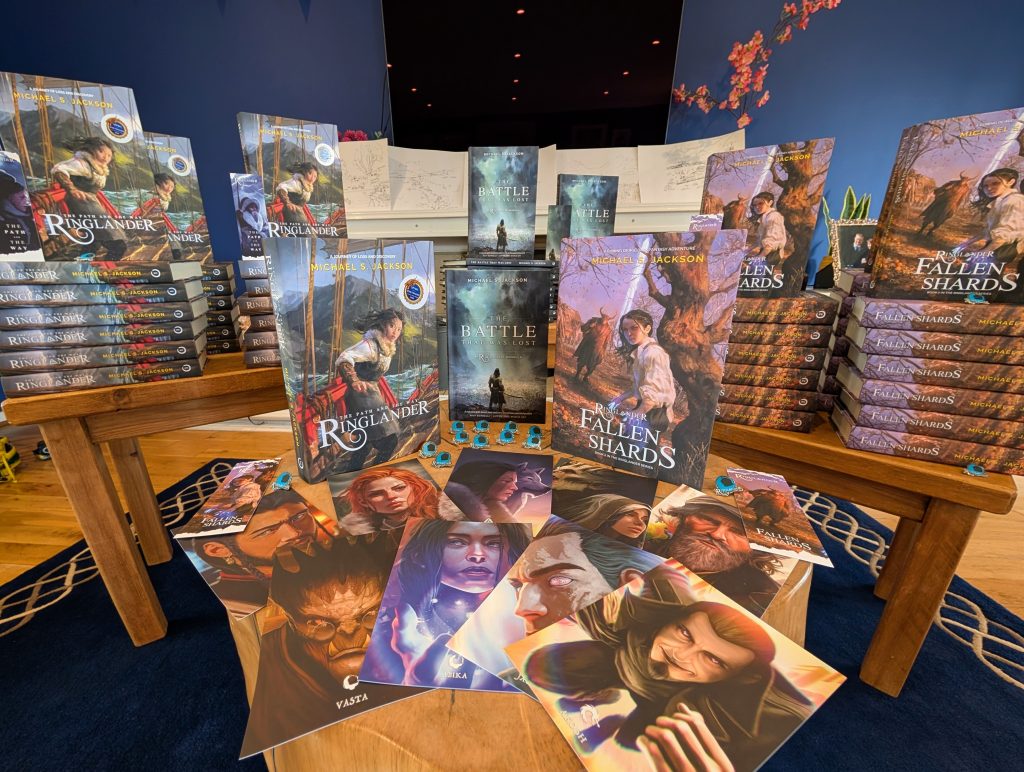
Ingram Spark and KDP dashboards
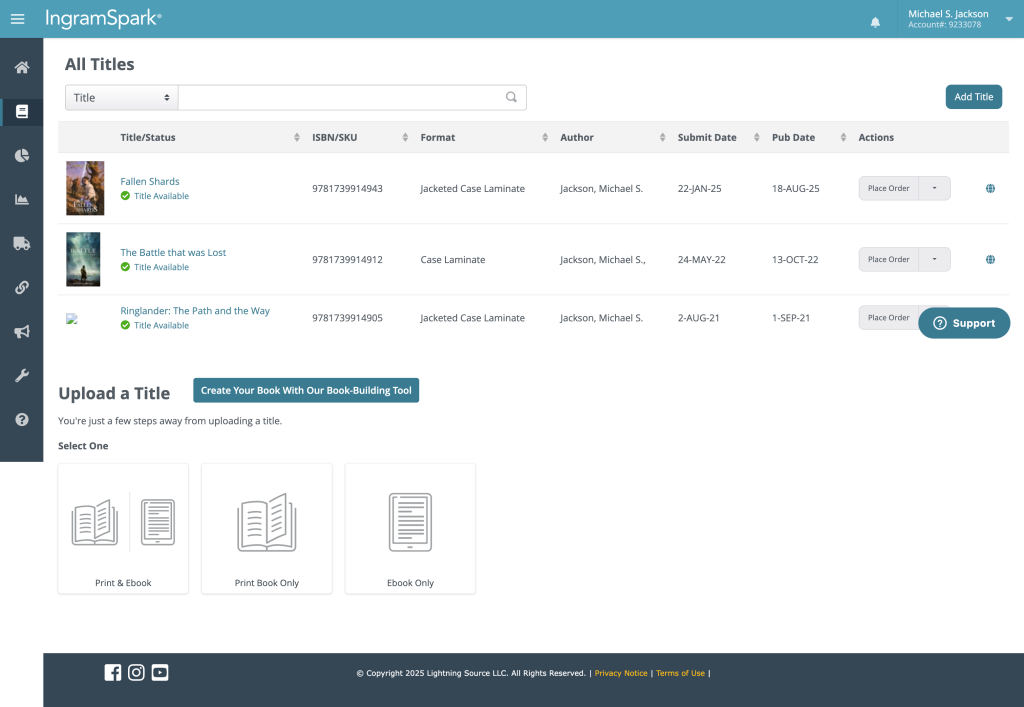
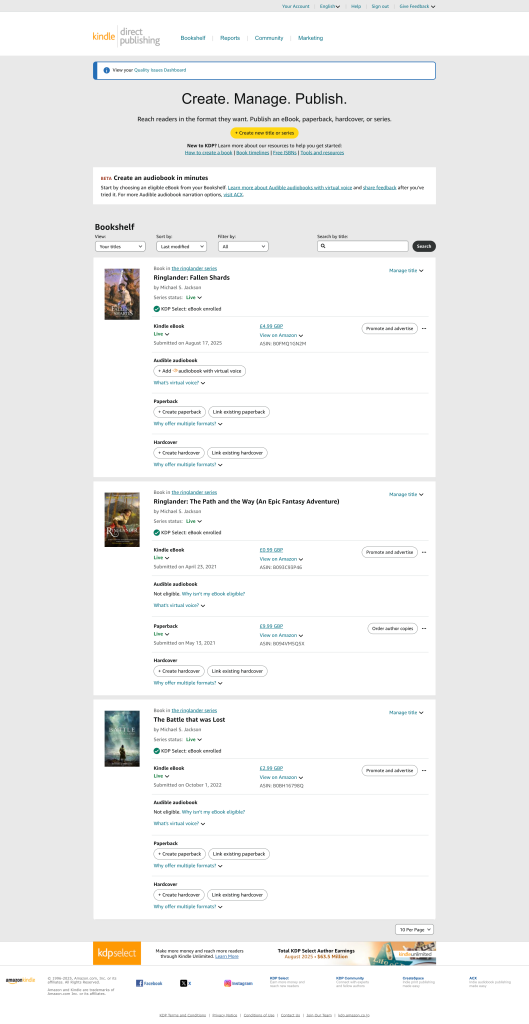
Bonus Step – Marketing
So which is better? KDP or Ingram Spark? Or what about Book Baby or PublishDrive? There is a plethora of platforms out there. Wow, try saying that one fast!
Which is best depends on luck, as most authors will arrive at one through word of mouth. A little research can you lead you to discover that there are differences like region, exclusivity and longevity, on top of all the normal things like brand-trust, other services and so on. Check out this very handy article from Reedsy on the matter.
Going “wide” vs exclusive
Going wide means exactly what you think it does. Spread your books across multiple services, it’s harder to manage though, but that shouldn’t put you off. Exclusivity is the opposite, and more and more platforms are demanding you stay with them and only them, which is important to note. Because if you break exclusivity they can and will ban your books from their marketplaces.
Amazon
Amazon’s KDP service is incredible, there’s no two ways round it, and by publishing on KDP you automatically get on Amazon, which has a massive benefits. The quality of their printing is quite good too. You are, however, exclusive to KDP if you go that route.
Ingram Spark
Ingram Spark do things a little differently. They have their own distribution network that includes Amazon, Waterstones, Barnes and Noble and any and every other online book store in the world. Imagine that? And more and more we see the owners of those stores offering deals on books on their online databases. It’s a weird thing seeing Walmart selling your fantasy book in a Christmas deal, I tell you. But if you want maximum exposure, a distribution network will really help you. I actively advertise the bigger stores like Walmart and Indigo that stock my book online because it helps my credibility to show those logos on my site and link to my book on those other stores. The second someone buys a book through that store, it initiates the print-on-demand service to kick in and Ingram Spark send my book out to that customer. Boom, you just reached a new reader.
And that’s it!
This has been some of the highlights of my publishing journey so far. Is it the right way? I don’t know. Someone once told me that maybe your first series will be self published, and maybe your second will traditional and so on. Do what is right for you, just make sure to arm yourself with the available options before you choose. Then jump in and press the big button. One thing is for damn sure, if you write something and you’re proud of it, put it out there. You never know what might happen.
Join my mailing list
Be the first to know, and get exclusive offers & content, author editions and maps.
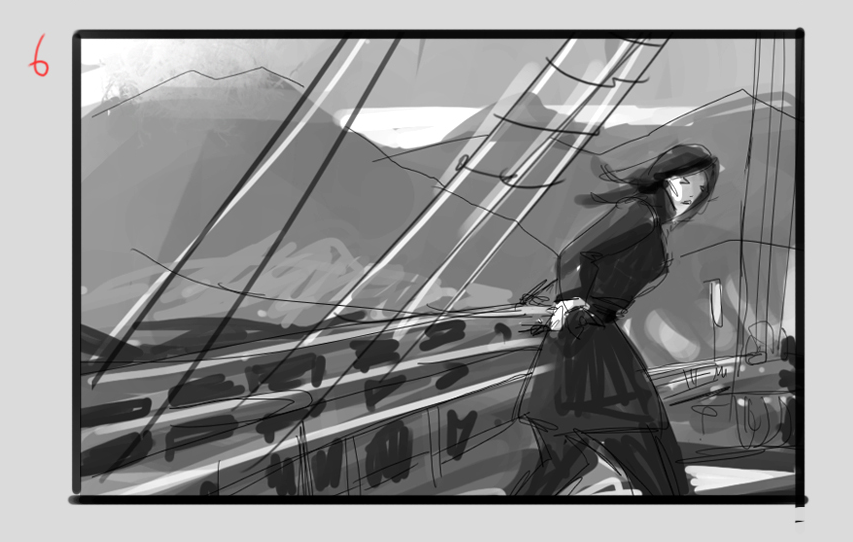
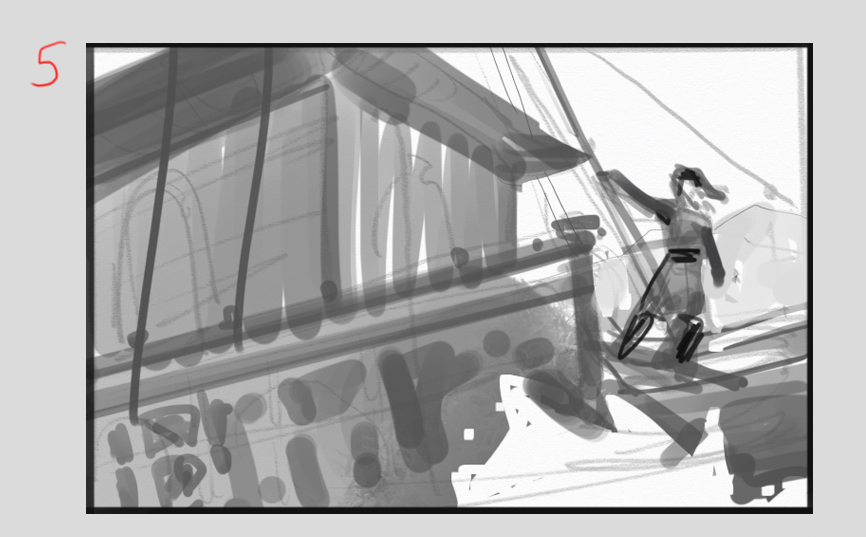
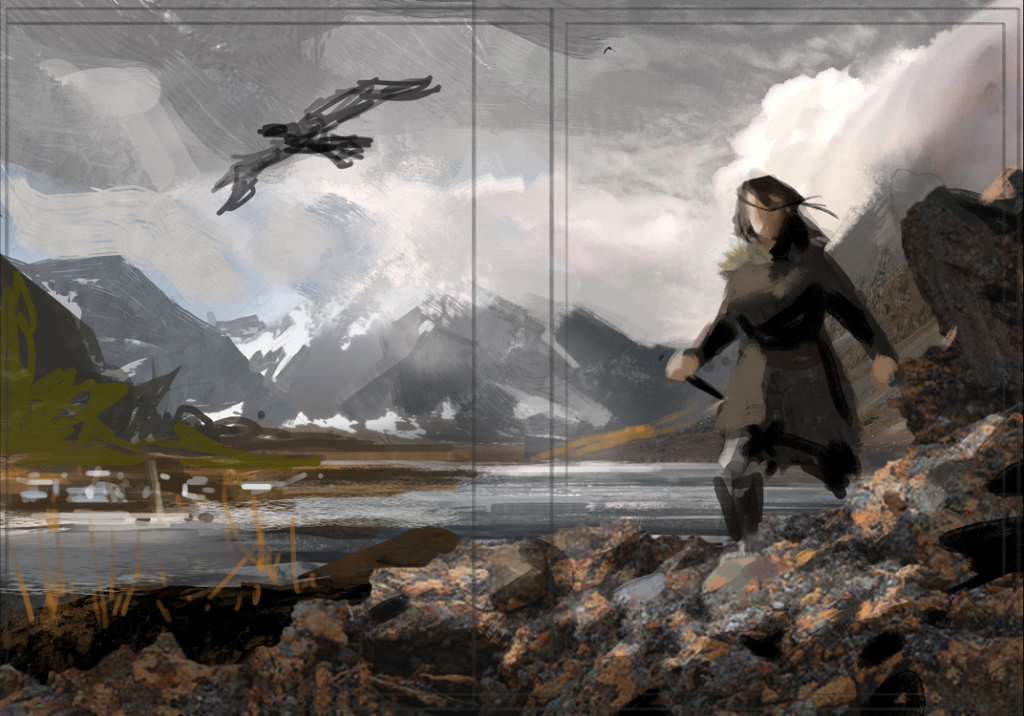
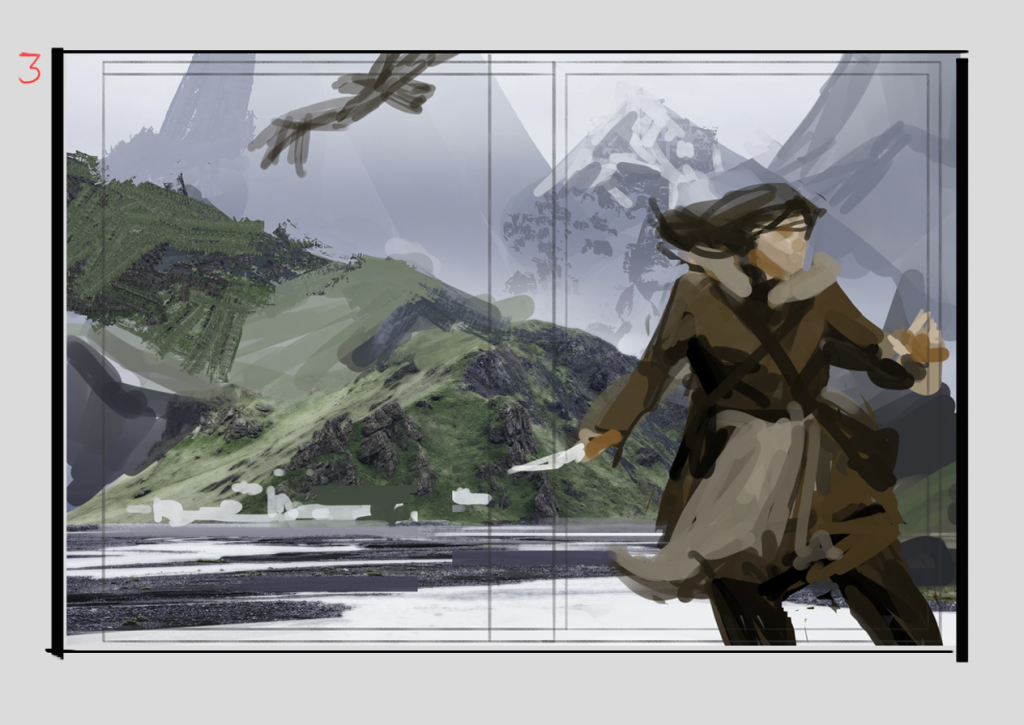
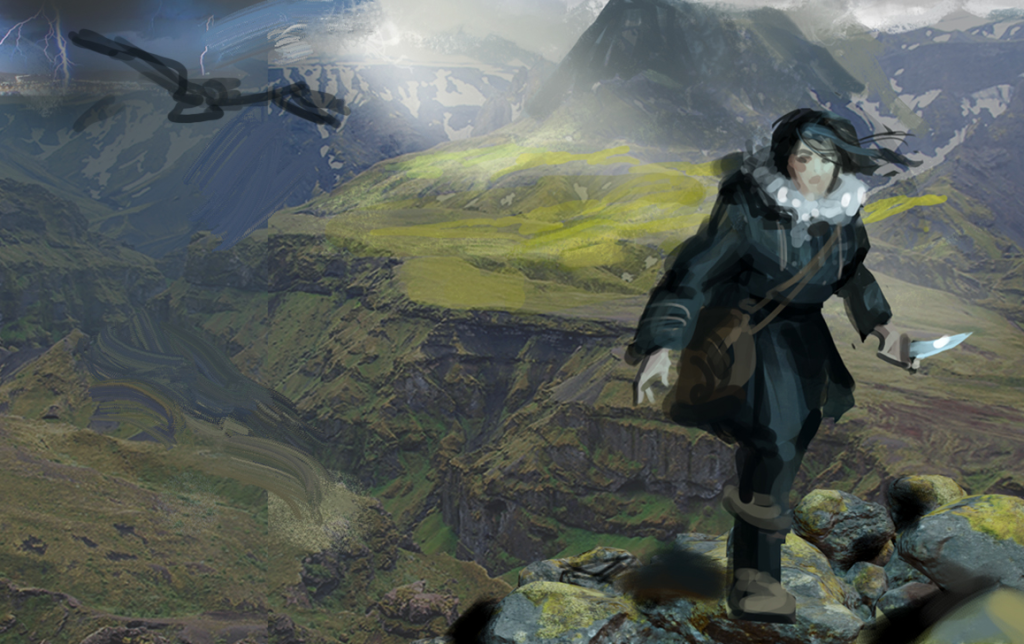
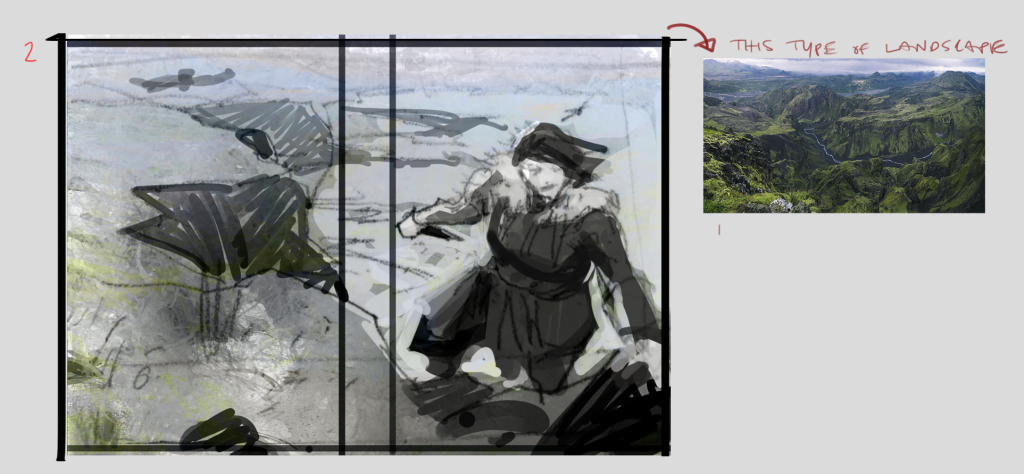
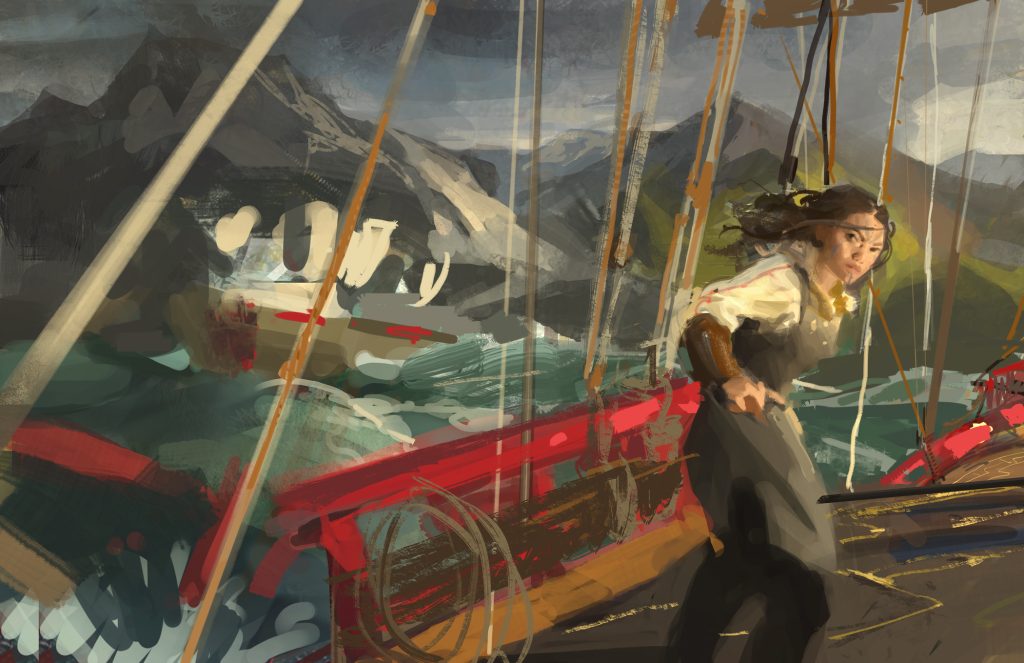
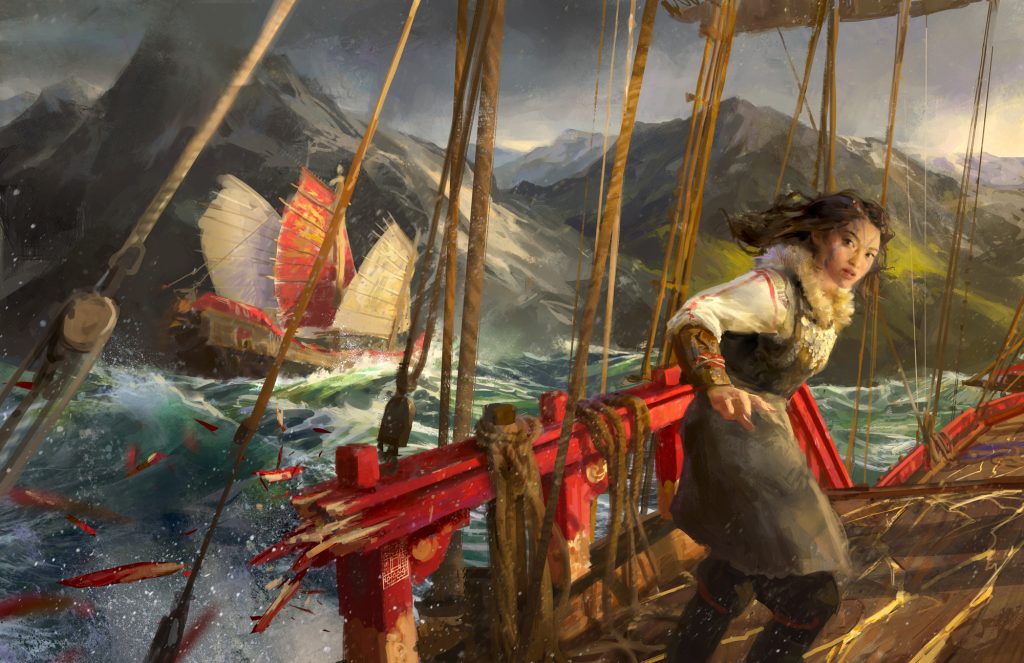

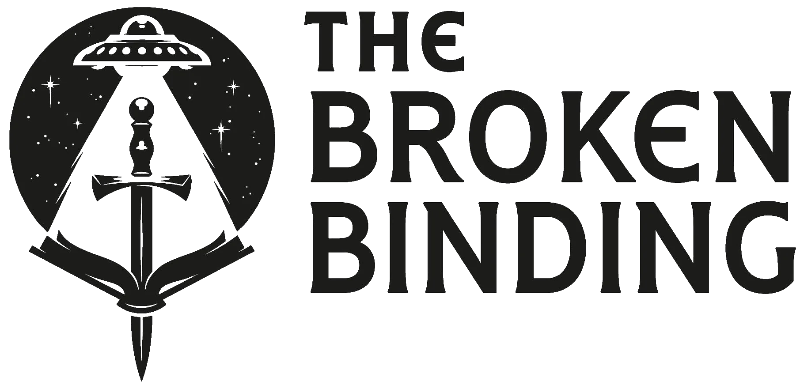





Comment on this article
Be the first to comment.